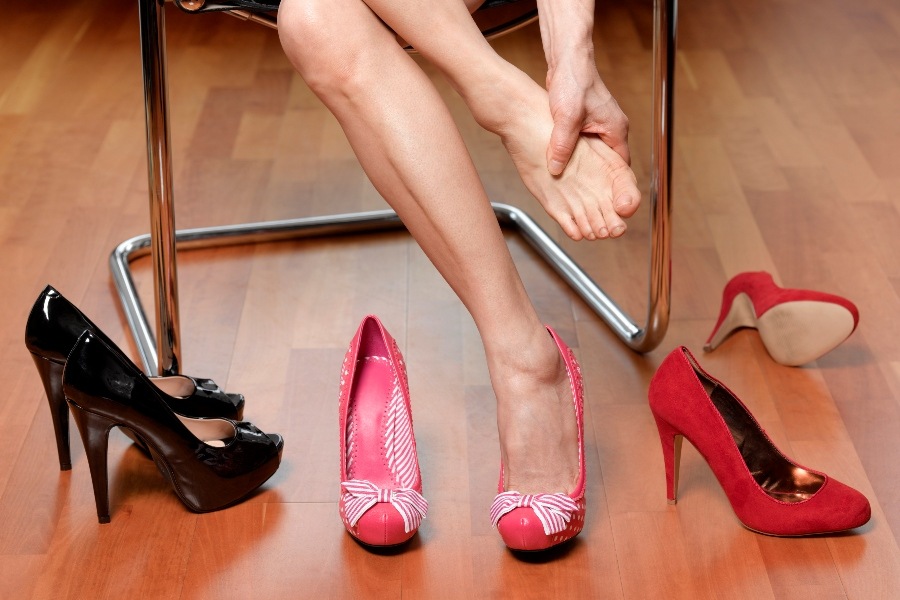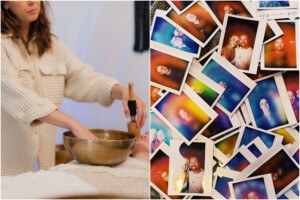Are Your Feet Hurting a Ton? Here’s How to Be More Shoe Smart
We turned to the pros to find out how you can give your aching feet much-needed relief.

Foot pain has been on the rise due to the pandemic. Three Philly-based experts share tips on how to prevent foot and ankle pain. / Photograph courtesy of Getty Images.
Now that the weather is getting nicer and more in-person events are taking place, it’s likely that you’re out and about way more than you have been recently. With the combo of socializing and non-frigid temps comes the desire to forgo hitching a ride in favor of hitting the town on foot — after all, Philly is a super walkable city.
But after two years of letting the shoe closet basically collect dust, you might find that wearing those statement heels, trendy mules, or high-top sneaks is harder — ahem, more painful — than it was before the age of working from home. That’s why we turned to three local foot and shoe experts to find out everything we need to know — and wear — in order to get some relief and prevent our dogs from barking so dang much.
Why your feet might be hurting
Foot pain is on the rise lately mainly due to lifestyle changes brought on by the pandemic. Elena Wellens, podiatric surgeon at Rothman Orthopaedic Institute, says that these past two years have caused a kind of “epidemic in the world of feet” because many people who have been working from home have been barefoot or shoeless most of the time. “This is not kind to certain foot types, especially flat feet or rigid/high-arch feet,” she says. “Conditions such as plantar fasciitis, foot and ankle tendonitis, and flare-ups of mid-foot arthritis have reared their ugly heads, and going barefoot aggravates these conditions because the feet are lacking the structural support and shock absorption that shoes provide.”
About those new blisters you might have…
Jordan Katz, podiatrist at Advanced Foot & Ankle in Vineland, New Jersey, says blisters can be the body’s reaction to a pathogen, like athlete’s foot or a bacterial infection. “They can come from mechanical forces including excessive rubbing on the skin, possibly from sweaty shoes or ones that are too big or too small — they all cause friction to the skin,” he says. This can lead to an allergic skin reaction, meaning that a blister that might’ve simply been uncomfortable and coverable with a bandaid in the past is now bringing on itchiness and swelling. The pandemic might have something to do with this change, especially if the skin on your feet hasn’t been exposed to that shoe’s material ever or in a long time. He says there have also been new diagnoses of “COVID toes,” which can present as painful toes that are blue or purple in color, or with small-to-medium-sized blisters or raised bumps and pain.
All about the shoes
After working from and being at home so much, it’s almost as if we need “training heels” — just like learning to ride a bike again. We can’t expect our feet to go from wearing slippers at home to jumping into a pair of shoes that haven’t been worn in ages. Here’s everything you need to know about best footwear practices.
How should your shoes really fit?
“Ideally, there should be a thumb’s width between the end of your big toe to the edge of the shoe,” says Elena Brennan, owner of Bus Stop Boutique in Queen Village and seasoned footwear expert. “You don’t want your toes to butt up against the edge of the shoe as then you’ll be prone to ingrown toenails. As far as the ankle is concerned, you really do not want any extra room in your shoe as that’s just asking for blisters. However, it’s a bit of a different story with boots, as you want your heel to move in the back for extra comfort and flexibility. Some customers feel that if their ankle slips in the back that they’re too big, but that’s not the case.”
The right sneakers
Katz says you should perform three tests purchasing sneakers. First is the toe bend test: When you push the front of the shoe towards the back, it should only bend in the toes. If it bends like an inverted arc the midsole, it’s too flimsy and lacks support. Second comes the twist test: If you twist the midsole of the shoe and it feels firm, that signals a supportive shoe. If you can easily twist the shoe, it lacks mid-arch support. Last is the heel cup squeeze test: Lightly squeeze the heel cup of the shoe — it should feel firm. If it collapses, then it won’t control the rearfoot well enough. For a sneaker that has great internal arch support, Katz recommends getting a pair of sneakers fitted with custom orthotics from a specialist so you can have “happy feet, knees, hips, and back.”
The right dress shoes
“Once patients return to working in the office and are back in dress shoes the above tips are very important to reduce acute onset of pain,” Wellens says. “Heels in particular can put quite a bit of stress on the forefoot, so I suggest starting with lower profile heels and gradually return to higher heels. Silicone pads for the forefoot can be helpful for any dress shoe, as well.”
Brennan adds that you should think about the material of all shoes, but especially for ones you’ll be wearing to work or to a professional event. “When buying a new shoe, make sure that there isn’t too much room as they will stretch out and cause blisters,” she says. “Suede stretches the most, then leather and after that would be nubuck and patent leathers.” Now’s also a good reminder to break your shoes in gently — wear them for one or two hours around the house first before gradually increasing your use both indoors and outdoors. The worst thing you can do, Brennan says, is to buy new shoes and wear them immediately to an event. You’re bound to get blisters or foot pain.
The right shoes for walking long distances in the city, especially when athletic sneakers are not an option
Brennan says when walking in the city, opt for a shoe that has a padded footbed and a substantial outer sole (nothing too flat or hard), and if you can, wear leather as this allows your foot to breathe. This can be an oxford shoe, boot, wedge or anything with a lug sole. She loves Woden, a sneaker brand from Denmark, for their removable cork insoles. “The cork makes it super cushiony and comfortable, but if you need to add an orthotic insole, it’s so easy to remove the cork one.” Brennan’s in-house line is also a great option, as the sneaker features a thick rubber sole and is lined with a soft leather (as opposed to synthetic materials). Bonus: They don’t look like an athletic sneaker, meaning you can wear them with workwear, a dress or fun pantsuit, or a casual pair of trousers or jeans. Versatility!
The right at-home footwear
When you’re in the comforts of your own home, you likely go shoeless — sporting socks or going completely barefoot — or wear a pair of comfy slippers. Unfortunately, neither will help keep your feet and ankles supported. If you’re reluctant to wear sneakers or closed shoes inside, Wellens recommends sandals like Birkenstocks, which offer stability and structured arch support.
Ways to protect the top of your foot
“If you have a high arch or instep, you want to avoid a strap that goes across the top of your foot or a shoe that is cut high,” Brennan says. Making sure your shoe laces aren’t tied too tight will also help avoid aggravating the top of your foot, she adds.
General day-to-day tips
When your feet hurt, everything else seems to hurt. Katz says the best things you can do to prevent foot and ankle aches is to wear supportive shoes with inserts (prefabricated or custom-molded to the patient’s foot prescription), exercise or move your body if you can, and see a podiatrist sooner rather than later if you experience pain. Wellens adds that stretching daily can help relax your calf muscles and foot arches, and reduce pain in the plantar fascia and tendons, including the achilles. And finally, save the flip flops for the beach, pool, or pedicure.


